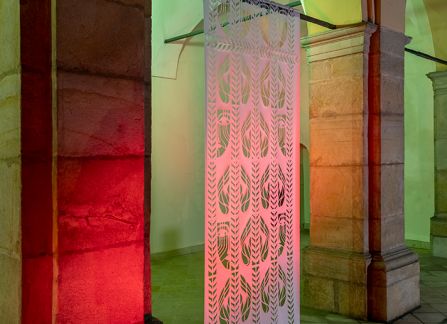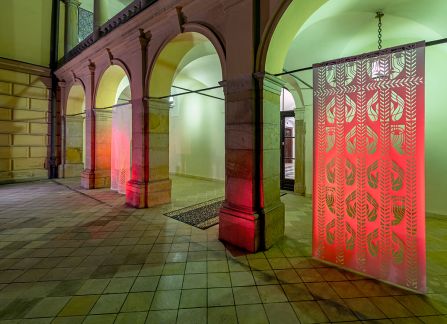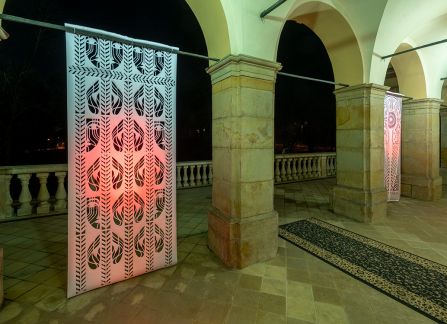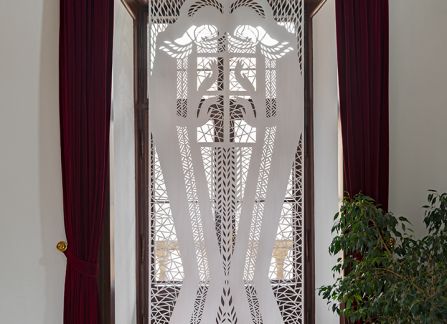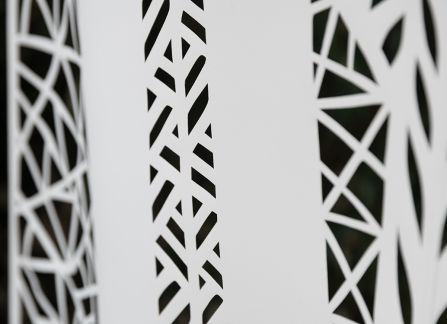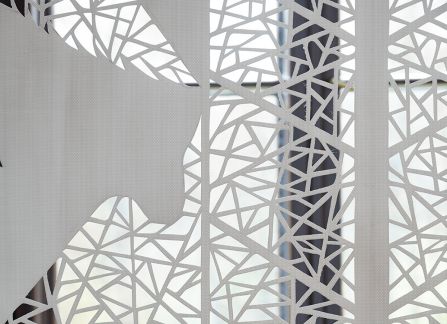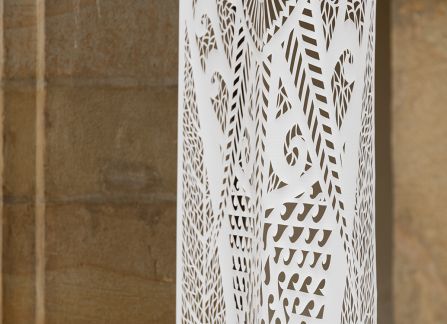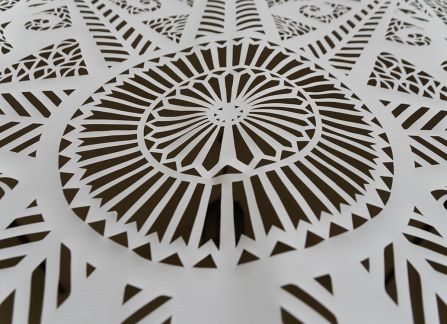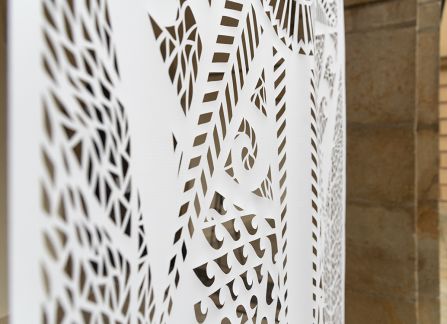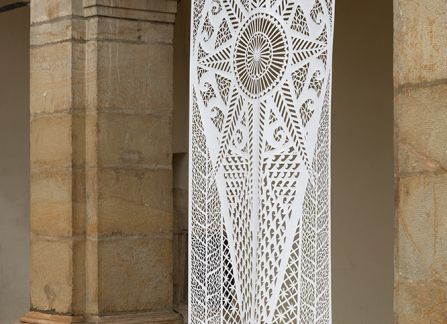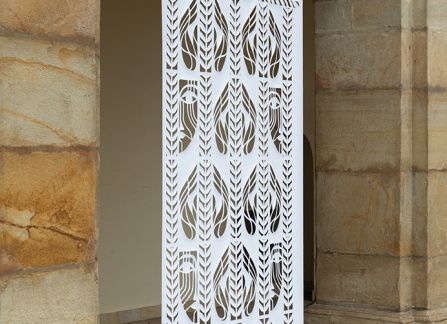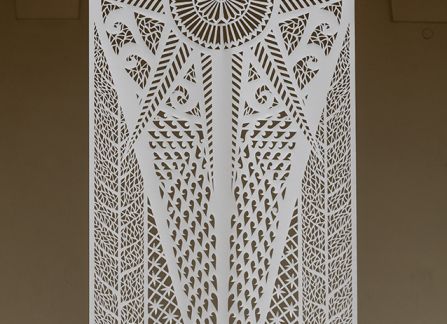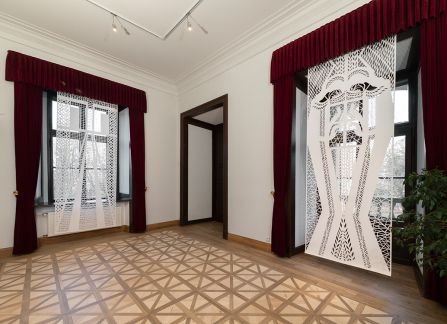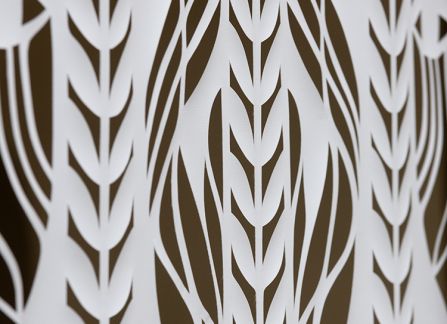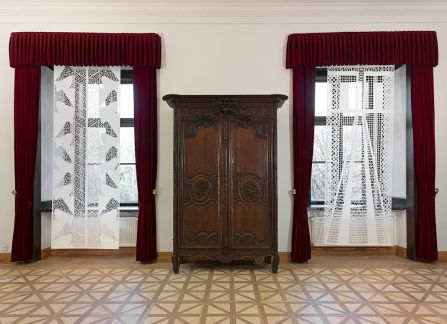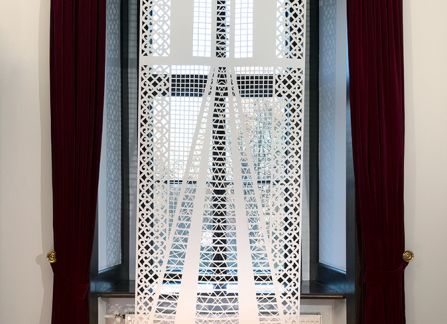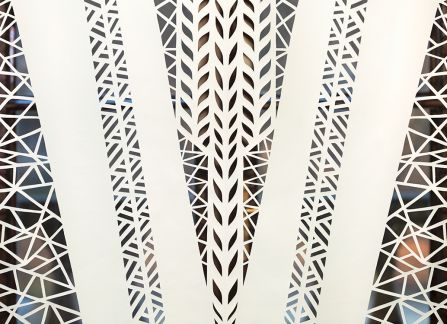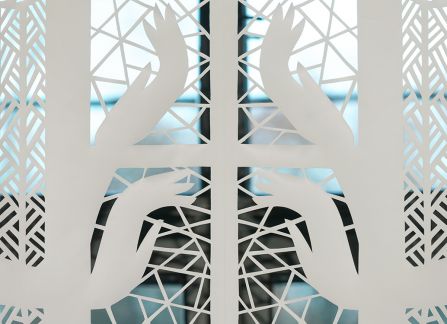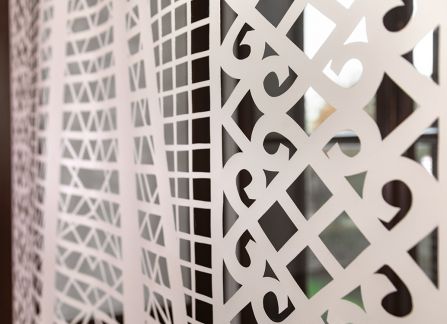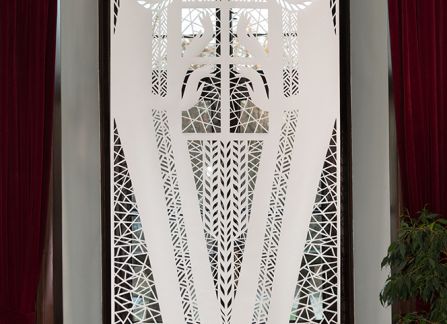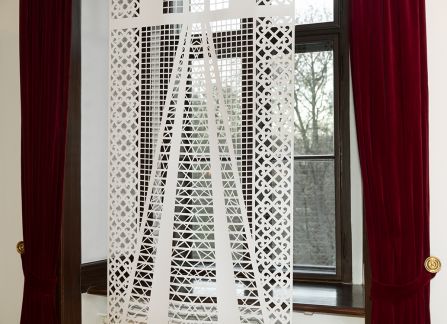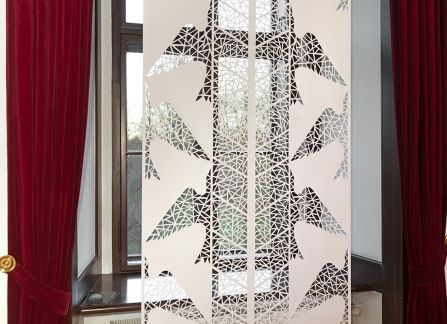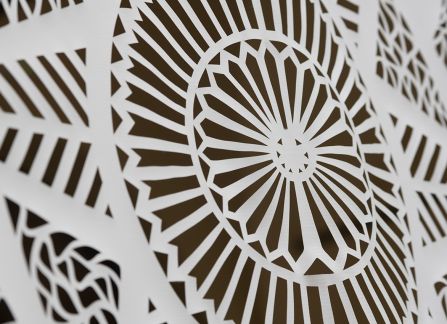Exhibition “Lace of Memory”
In the memory of the victims of the Great Famine in Ukraine (1932-1933)
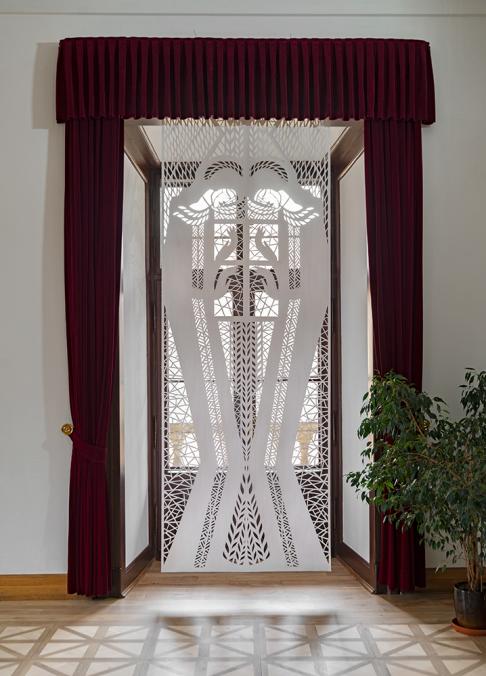
In the memory of the victims of the Great Famine in Ukraine (1932-1933)
An Ukrainian papercuts exhibition “Lace of Memory”
On the anniversary of the Great Famine in Ukraine, you can admire stunning papercuts by Daria Alyoshkina under the Villa Decius’s Archways.
The story of the Great Famine is shown on pieces of embroidery which present pictures created based on testimonies of those who survided the genocide. These incredibly intricate works tell the story of the repression during the Great Famine and make one reflect about the black boards, the law of spikelets, the closed borders of the starving Ukraine. They also express the Ukrainian resistance against the Bolshevik government.
The author of the projects is DARIA ALYOSHKINA – a masterful artist, who not only gave new life to the ancient Ukrainian papercutting craft, but also turned it into a modern art and showed to the world through her enormous artworks. The artist’s love for papercuts is deeply rooted in her childhood spent in a picturesque village in the Vinnytsia Oblast, where her parents, both renowned artists, moved from Kiev after the birth of their children. This was the place where Daria once again learnt to perceive tradition, read symbols, feel them around her, and grasp a deep sense of the surrounding nature. During the preparation of the “Lace of Memory” project, she mostly used her own memories, as well as the stories of people who survived the Great Famine.
The interview with Daria Alyoshkina:
VDIC: Where did the idea come from to convey the history of the Great Famine in Ukraine in such a form of art as cutouts?
D.A. In 2019, I was approached by representatives of the National Museum "Memorial of the Victims of the Great Famine" in Kiev with a proposal to carry out a joint project based on cutouts. The idea and the task seemed very complicated, but I agreed immediately, since this subject is very close to me due to the fact that I grew up in the countryside, where the Holodomor was never talked about officially. The museum sent their suggestions and the memoirs in text, and I tried to recreate them on paper. Among the topics presented, there were themes about "black boards", about the "Law of Spikelets", about the closed borders in the starving Ukraine, about resisting the Soviet authorities.
VDIC: Please elaborate on the topic of authentic memories contained in the "Lace of Remembrance" project.
D.A. I will quote the memories of several people:
"Autumn has come, the time to harvest the crops, the fields were safeguarded, the guards were watching. People were too scared to come near a field. When they went out to harvest – it was risky to even take a grain in one's mouth. If anyone saw it, they could have you sentenced to ten years or more. While harvesting the crops, some people silently picked grain ears, but this was not allowed. Mańka crept into the field, although she was only a child. She was caught and the security beat her so badly that her blood-soaked shirt stuck to her back. I thought that I wouldn't be able to look after her, that she would die."
Palashka Vasylivna Panasenko, born in 1901 (village of Luka, Łochwyćkyj district, Poltava Oblast)
"They took bread away from us, the people and I, along with the little boys, rushed to pick up the grains. However, picking grain ears was prohibited: nothing was allowed, no food would be sought, we were only permitted to die. I wore a bag around my neck with which we would go picking ears, and the ears were full of grains, which meant there would be bread; the harvest was plentiful, and you could, so to speak, not die. To prevent people from picking up grains, the crops were guarded by guards on horses. They rode on horses and bore knouts. I remember that terrible moment. We were all scared of these guards. One of the boys called out: "Soldier!". A man on a horse showed up and approached us. Everyone started to run; me too, I think I was the youngest, because they ran faster and I was behind and I could feel the beat of the horses. I stood in place and he was already approaching me, the horse's muzzle was right next to me. I stood and watched, as he swung his whip and then looked at me – I was 6 years old at the time – I think he saw such terror in my eyes that he merely spat, turned his horse and rode away. He didn't hit me."
Mykola Onyschenko, village of Roza, Berdyansk district, Zaporizhia Oblast.
"And the neighboring village that was called Semyhirja, some 8 km from us; the whole village revolted there and they did not let any of the regional representatives inside, they were like a small republic. Then a regiment of soldiers from Kremenchuk were called in, and since the village was in a valley, it was surrounded by soldiers deployed on the hills, shooting at everything moving in the village.
And in our village there was a women's revolt, but there was no army. There was a woman, I can't recall the name, who called out: "Let's all go together, tear down the equipment, take the horses we brought, and we'll be fine." And then everyone went to where some seed drills and plows were standing, and they dismantled them, while the authorities could do nothing but say, agitated: "Halt!". Nobody would listen; they all took their belongings and went home. The horses took home everything there was to take. Here is an example of such woman's revolt. And those were women, the men stood by. And I was there too. The representatives would say: "Go to the kolkhoz voluntarily," they would encourage us, and when the kolkhoz was active, they would say we went there voluntarily. Another says: "Voluntarily?! But you dragged us to the kolkhoz with a sickle by the heart! That's how voluntarily we went! It was a planned famine to weaken the potential strength of the Ukrainian people and it was a deliberate action."
Hryhorii Kuksa (born March 20, 1920 in the village of Arsenivka, Kirovohrad Oblast), Winnipeg, Canada
"We often visited the town of Kramatorsk. These unfortunate children were not allowed to go to the countryside, since they were not allowed entrance, so as not to see people there. Patrols were organized, the so-called NKVD home troops that did not let people go into the villages. These unfortunate children and starving people fled from other regions to Donetsk and mostly stayed at stations and parks. For example, I remember seeing many corpses in Lenin Park, not only of adults, but also of children."
Aleksander Seweryn (born 1922, village of Słoboda, Donetsk Oblast), New Jersey, United States
D.A. When creating my cutouts, I also took into account the memories of my family:
My great-grandfather (on my mother's side) Mykhailo Stepanovich Safonov was the head of the kolkhoz in the village of Vila Yaruzki in the Vinnytsia Oblast. During the Holodomor, he distributed grains to people, which resulted in repression. My great-grandmother Katarina Jablonska had a cow during the famine, which allowed them to survive. They also had small children and a nanny, and my great-grandmother shared milk with her family as well. When my mother returned to the village in the 1980s, this nanny's family met with her; they cried and hugged one another, saying "your grandmother has saved our whole family from hunger".
In the center of our garden there was a sacred tree - a hawthorn, which we were not allowed to break or cut down. My mother said that it was this tree that saved people from starvation with its fruit.
In the village cemetery there is a memorial with an inscription: "There is no worse death than through starvation".
VDIC: There is a lot of symbolism in the pieces at the "Lace of Remembrance " exhibition; how are we to read the individual elements of the project?
D.A. In the piece entitled "Resistance of the Ukrainians to the Soviet authorities", in the center I presented a spiky tree, with birds flying upwards on both sides. As a symbol of freedom, movement and hope, a bird tries to get out of captivity, much like people who, despite strict prohibitions and laws, did not lose hope and fought on. Another cutout entitled "The Black Board" shows two angels mourning by a window, reminding us that poverty has visited every home. The piece "Closed Borders", in turn, symbolizes rail tracks, with a cross at the end, referring to the destruction of the Ukrainian nation, which occurred on all sides, when people could not leave their towns and villages. A cutout entitled "The Law of Spikelets" – an image of an ear and human hands – here I aimed to emphasize how valuable a slice of bread was.
VDIC: What is the genesis of you creating large-format cutouts?
D.A. From time immemorial, the windows at home were decorated with cutouts. Based on their traditional use, I began creating with the same method – but modern windows have become large, which is why my cutouts are so as well.
VDIC: What materials do you use in your work?
D.A. I usually work with paper; it is quite thick, high-density paper that can withstand loads and is durable in use. The exhibitions were often held outdoors and of course the cutouts could not withstand rain, snow and frost – so I was looking for a material that would fit the cutting technique and would be resistant to weather conditions. Using vinyl, I can safely make decorations anywhere.
VDIC: Are all your pieces white or have there ever been any colorful cutouts?
D.A. I work with colored paper, too. You can buy white roll paper anywhere, but colored paper is quite the problem, so when I make a large color cutout, I more often glue several pieces together.
VDIC: What is the process of creating your cutouts; do you do sketches and drawings beforehand?
D.A. All my works follow the traditional pattern – folding the paper in half. This is exact symmetry. When making such a large cutout, I draw a rough sketch in a smaller format and then transfer the image to a large sheet folded in half.
An Ukrainian papercuts exhibition “Lace of Memory”
On the anniversary of the Great Famine in Ukraine, you can admire stunning papercuts by Daria Alyoshkina under the Villa Decius’s Archways.
The story of the Great Famine is shown on pieces of embroidery which present pictures created based on testimonies of those who survided the genocide. These incredibly intricate works tell the story of the repression during the Great Famine and make one reflect about the black boards, the law of spikelets, the closed borders of the starving Ukraine. They also express the Ukrainian resistance against the Bolshevik government.
The author of the projects is DARIA ALYOSHKINA – a masterful artist, who not only gave new life to the ancient Ukrainian papercutting craft, but also turned it into a modern art and showed to the world through her enormous artworks. The artist’s love for papercuts is deeply rooted in her childhood spent in a picturesque village in the Vinnytsia Oblast, where her parents, both renowned artists, moved from Kiev after the birth of their children. This was the place where Daria once again learnt to perceive tradition, read symbols, feel them around her, and grasp a deep sense of the surrounding nature. During the preparation of the “Lace of Memory” project, she mostly used her own memories, as well as the stories of people who survived the Great Famine.
The interview with Daria Alyoshkina:
VDIC: Where did the idea come from to convey the history of the Great Famine in Ukraine in such a form of art as cutouts?
D.A. In 2019, I was approached by representatives of the National Museum "Memorial of the Victims of the Great Famine" in Kiev with a proposal to carry out a joint project based on cutouts. The idea and the task seemed very complicated, but I agreed immediately, since this subject is very close to me due to the fact that I grew up in the countryside, where the Holodomor was never talked about officially. The museum sent their suggestions and the memoirs in text, and I tried to recreate them on paper. Among the topics presented, there were themes about "black boards", about the "Law of Spikelets", about the closed borders in the starving Ukraine, about resisting the Soviet authorities.
VDIC: Please elaborate on the topic of authentic memories contained in the "Lace of Remembrance" project.
D.A. I will quote the memories of several people:
"Autumn has come, the time to harvest the crops, the fields were safeguarded, the guards were watching. People were too scared to come near a field. When they went out to harvest – it was risky to even take a grain in one's mouth. If anyone saw it, they could have you sentenced to ten years or more. While harvesting the crops, some people silently picked grain ears, but this was not allowed. Mańka crept into the field, although she was only a child. She was caught and the security beat her so badly that her blood-soaked shirt stuck to her back. I thought that I wouldn't be able to look after her, that she would die."
Palashka Vasylivna Panasenko, born in 1901 (village of Luka, Łochwyćkyj district, Poltava Oblast)
"They took bread away from us, the people and I, along with the little boys, rushed to pick up the grains. However, picking grain ears was prohibited: nothing was allowed, no food would be sought, we were only permitted to die. I wore a bag around my neck with which we would go picking ears, and the ears were full of grains, which meant there would be bread; the harvest was plentiful, and you could, so to speak, not die. To prevent people from picking up grains, the crops were guarded by guards on horses. They rode on horses and bore knouts. I remember that terrible moment. We were all scared of these guards. One of the boys called out: "Soldier!". A man on a horse showed up and approached us. Everyone started to run; me too, I think I was the youngest, because they ran faster and I was behind and I could feel the beat of the horses. I stood in place and he was already approaching me, the horse's muzzle was right next to me. I stood and watched, as he swung his whip and then looked at me – I was 6 years old at the time – I think he saw such terror in my eyes that he merely spat, turned his horse and rode away. He didn't hit me."
Mykola Onyschenko, village of Roza, Berdyansk district, Zaporizhia Oblast.
"And the neighboring village that was called Semyhirja, some 8 km from us; the whole village revolted there and they did not let any of the regional representatives inside, they were like a small republic. Then a regiment of soldiers from Kremenchuk were called in, and since the village was in a valley, it was surrounded by soldiers deployed on the hills, shooting at everything moving in the village.
And in our village there was a women's revolt, but there was no army. There was a woman, I can't recall the name, who called out: "Let's all go together, tear down the equipment, take the horses we brought, and we'll be fine." And then everyone went to where some seed drills and plows were standing, and they dismantled them, while the authorities could do nothing but say, agitated: "Halt!". Nobody would listen; they all took their belongings and went home. The horses took home everything there was to take. Here is an example of such woman's revolt. And those were women, the men stood by. And I was there too. The representatives would say: "Go to the kolkhoz voluntarily," they would encourage us, and when the kolkhoz was active, they would say we went there voluntarily. Another says: "Voluntarily?! But you dragged us to the kolkhoz with a sickle by the heart! That's how voluntarily we went! It was a planned famine to weaken the potential strength of the Ukrainian people and it was a deliberate action."
Hryhorii Kuksa (born March 20, 1920 in the village of Arsenivka, Kirovohrad Oblast), Winnipeg, Canada
"We often visited the town of Kramatorsk. These unfortunate children were not allowed to go to the countryside, since they were not allowed entrance, so as not to see people there. Patrols were organized, the so-called NKVD home troops that did not let people go into the villages. These unfortunate children and starving people fled from other regions to Donetsk and mostly stayed at stations and parks. For example, I remember seeing many corpses in Lenin Park, not only of adults, but also of children."
Aleksander Seweryn (born 1922, village of Słoboda, Donetsk Oblast), New Jersey, United States
D.A. When creating my cutouts, I also took into account the memories of my family:
My great-grandfather (on my mother's side) Mykhailo Stepanovich Safonov was the head of the kolkhoz in the village of Vila Yaruzki in the Vinnytsia Oblast. During the Holodomor, he distributed grains to people, which resulted in repression. My great-grandmother Katarina Jablonska had a cow during the famine, which allowed them to survive. They also had small children and a nanny, and my great-grandmother shared milk with her family as well. When my mother returned to the village in the 1980s, this nanny's family met with her; they cried and hugged one another, saying "your grandmother has saved our whole family from hunger".
In the center of our garden there was a sacred tree - a hawthorn, which we were not allowed to break or cut down. My mother said that it was this tree that saved people from starvation with its fruit.
In the village cemetery there is a memorial with an inscription: "There is no worse death than through starvation".
VDIC: There is a lot of symbolism in the pieces at the "Lace of Remembrance " exhibition; how are we to read the individual elements of the project?
D.A. In the piece entitled "Resistance of the Ukrainians to the Soviet authorities", in the center I presented a spiky tree, with birds flying upwards on both sides. As a symbol of freedom, movement and hope, a bird tries to get out of captivity, much like people who, despite strict prohibitions and laws, did not lose hope and fought on. Another cutout entitled "The Black Board" shows two angels mourning by a window, reminding us that poverty has visited every home. The piece "Closed Borders", in turn, symbolizes rail tracks, with a cross at the end, referring to the destruction of the Ukrainian nation, which occurred on all sides, when people could not leave their towns and villages. A cutout entitled "The Law of Spikelets" – an image of an ear and human hands – here I aimed to emphasize how valuable a slice of bread was.
VDIC: What is the genesis of you creating large-format cutouts?
D.A. From time immemorial, the windows at home were decorated with cutouts. Based on their traditional use, I began creating with the same method – but modern windows have become large, which is why my cutouts are so as well.
VDIC: What materials do you use in your work?
D.A. I usually work with paper; it is quite thick, high-density paper that can withstand loads and is durable in use. The exhibitions were often held outdoors and of course the cutouts could not withstand rain, snow and frost – so I was looking for a material that would fit the cutting technique and would be resistant to weather conditions. Using vinyl, I can safely make decorations anywhere.
VDIC: Are all your pieces white or have there ever been any colorful cutouts?
D.A. I work with colored paper, too. You can buy white roll paper anywhere, but colored paper is quite the problem, so when I make a large color cutout, I more often glue several pieces together.
VDIC: What is the process of creating your cutouts; do you do sketches and drawings beforehand?
D.A. All my works follow the traditional pattern – folding the paper in half. This is exact symmetry. When making such a large cutout, I draw a rough sketch in a smaller format and then transfer the image to a large sheet folded in half.
Daria Alyoshkina
Daria Alyoshkina – a pioneer artist who not only rediscovered the ancient Ukrainian papercutting craft, but also transformed it into modern art and made famous all over the world. Daria was the first to create large format papercuts. These enormous openwork sheets have become the crown jewel of many exhibitions and art projects in countries such as: Poland, Germany, France, South Korea, Canada, USA, Belgium, Austria, Switzerland, Denmark. All ornaments are the author’s original ideas, and every papercut is made entirely by hand. The main feature that makes them unique is their symmetry. Just like in the old days, a sheet of paper is folded evenly in half, and the ornament is cut out, resembling an amazing snowflake. The sheet is then unfolded, and you can see a huge paper lace!
It’s real magic. Daria’s artist biography includes hundreds of square meters of openwork paper sheets. Every one of them is unique as they are crafted based on “live”, improvised paintings, sketches that are never used twice. Just like snowflakes. Daria was the first to experiment with modern materials, which allowed for creating real art installations, theatrical sceneries, or public space adornments out of her decorative canvas.
Daria Alyoshkina created papercuts for a French decorator Isabelle Daëron, who has been arranging window displays for Hermès boutiques in Japan and France for many years. Daria worked with her on a special project for the Vsi.Svoi store in Kiev. She cooperated with jewelry stores, creating artworks for the Kiev Cartier store and for the jewelry brand Oberih. She was also invited by the Michelangelo Foundation to participate in the Venice Art Biennale.
Biography:
Daria Alyoshkina was born on 5 March 1982 in Kiev to a family of sculptors Oleksiy and Lyudmyla Alyoshkin. She grew up in eastern Podillia.
2001 – graduated from Vyzhnytsia College of Applied Arts in Vinnytsia.
2007 – graduated from the Lviv National Academy of Arts with a Master degree in monumental and decorative sculpture.
She works in functional and monumental sculpture, papercuts, graphics. Director in the “Dyv” Shadow Theater.
Since 1996, Daria has been taking part in exhibitions and symposia. Participant of more than thirty sculpture symposia in Ukraine, Poland, Lithuania. Her works can be found in such cities as: Kiev, Lviv, Chornomorsk, Zhovkva, Kolomyja, Svaliava, Kalush, Gdansk.
Since 2010, her large format papercuts have been representing Ukraine during international events. Poland, Germany, France, South Korea, USA, Belgium, Austria, Switzerland, Denmark – and many other countries where citizens had the opportunity to admire Daria’s works.
Her papercuts were used twice to adorn the Ukrainian stand during the famous Paris book fair “Livre Paris”. In 2018, Cartier decided to adorn their Kiev store with Daria’s works.
2019 – cooperation with French designer Isabelle Daëron on the window display decoration of a Kiev store.
2019 – the papercuts are presented in the UN headquarters in Swirzerland.
Invited by the Michelangelo Foundation to participate in the 2020 Venice Art Biennale (which, due to the situation in the world, hasn’t taken place yet).
She lives and works in Lviv, mother of three children.
It’s real magic. Daria’s artist biography includes hundreds of square meters of openwork paper sheets. Every one of them is unique as they are crafted based on “live”, improvised paintings, sketches that are never used twice. Just like snowflakes. Daria was the first to experiment with modern materials, which allowed for creating real art installations, theatrical sceneries, or public space adornments out of her decorative canvas.
Daria Alyoshkina created papercuts for a French decorator Isabelle Daëron, who has been arranging window displays for Hermès boutiques in Japan and France for many years. Daria worked with her on a special project for the Vsi.Svoi store in Kiev. She cooperated with jewelry stores, creating artworks for the Kiev Cartier store and for the jewelry brand Oberih. She was also invited by the Michelangelo Foundation to participate in the Venice Art Biennale.
Biography:
Daria Alyoshkina was born on 5 March 1982 in Kiev to a family of sculptors Oleksiy and Lyudmyla Alyoshkin. She grew up in eastern Podillia.
2001 – graduated from Vyzhnytsia College of Applied Arts in Vinnytsia.
2007 – graduated from the Lviv National Academy of Arts with a Master degree in monumental and decorative sculpture.
She works in functional and monumental sculpture, papercuts, graphics. Director in the “Dyv” Shadow Theater.
Since 1996, Daria has been taking part in exhibitions and symposia. Participant of more than thirty sculpture symposia in Ukraine, Poland, Lithuania. Her works can be found in such cities as: Kiev, Lviv, Chornomorsk, Zhovkva, Kolomyja, Svaliava, Kalush, Gdansk.
Since 2010, her large format papercuts have been representing Ukraine during international events. Poland, Germany, France, South Korea, USA, Belgium, Austria, Switzerland, Denmark – and many other countries where citizens had the opportunity to admire Daria’s works.
Her papercuts were used twice to adorn the Ukrainian stand during the famous Paris book fair “Livre Paris”. In 2018, Cartier decided to adorn their Kiev store with Daria’s works.
2019 – cooperation with French designer Isabelle Daëron on the window display decoration of a Kiev store.
2019 – the papercuts are presented in the UN headquarters in Swirzerland.
Invited by the Michelangelo Foundation to participate in the 2020 Venice Art Biennale (which, due to the situation in the world, hasn’t taken place yet).
She lives and works in Lviv, mother of three children.


